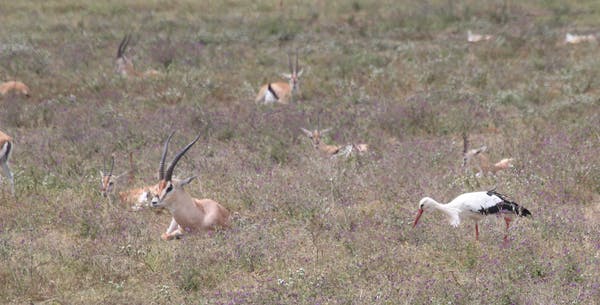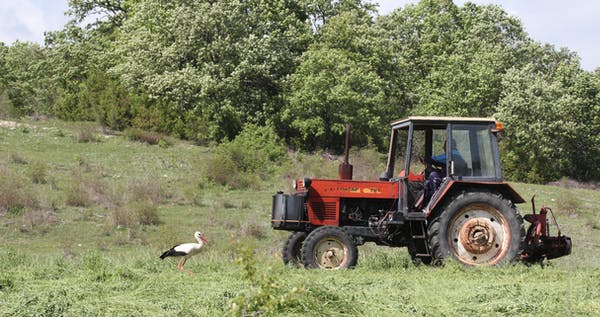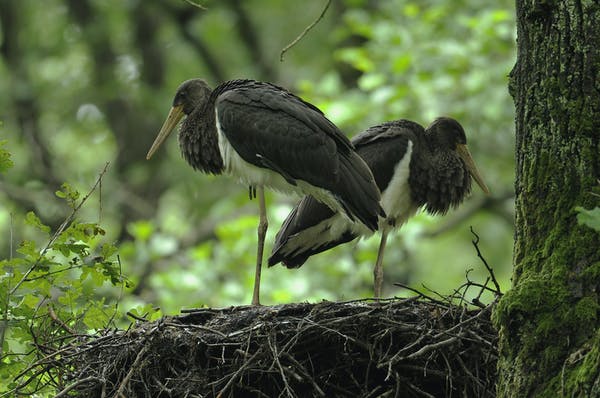Jerri-Lynn here. Some small cause for optimism: stork chicks hatch in the United Kingdom for the first time in centuries. I post this story to give readers a small break from contemplating the worldwide COVID-19 pandemic. I need one; I think some of you might too.
By Alexander C. Lees,Senior Lecturer in Conservation Biology, Manchester Metropolitan University and Oliver Metcalf, Senior Lecturer in Conservation Biology, Manchester Metropolitan University. Originally published at The Conversation
In a spring marked by bad news, events unfolding in the crown of an old oak tree could offer a dose of optimism. Three pairs of white storks settled down to breed on the Knepp Estate in West Sussex, southern England, in March 2020. On May 15, it was announced that the first chicks had hatched – the first to be born in Britain since a pair nested on the roof of St Giles Cathedral in Edinburgh in 1416.
This was no chance event – we owe this precious conservation breakthrough to the efforts of all those involved in the White Stork Project, who have released over 100 storks at three sites in southeast England.
Wildlife, such as the storks and the white-tailed eagles reintroduced to the Isle of Wight in 2019, has provided a lockdown distraction. Both species have treated garden birdwatchers to spectacular sights as they’ve toured southern England, and in the case of the eagles even further afield.
Visitors at Shipley Church #WestSussex #birdwatching #birdphotography #lovenature #Christening @BBCSpringwatch @lucyinthewild @SussexEmerald #WhiteStorkProject @kneppcastle the stork programme is generating such interest #HomeSchooling #DailyExercise #StayHealthy ? pic.twitter.com/o6tal5MSaP
— Malcolm Green (@countrymanpics) April 28, 2020
Stork bones have been found in the limestone caves of the Peak District dating from the late glacial period, between 43,000 and 10,000 years ago, and in human settlements from the Isle of Scilly to the Shetlands in the Bronze Age, as far back as 2,500 years ago. But their sparse remains suggest that they were probably always rare in the UK.
Despite this, the history of Britons living alongside storks is preserved in place names like Storrington, close to the Knepp estate, which in Saxon times was called “Estorchestone” – village of the storks. But storks, along with other large wetland birds like cranes and spoonbills, were erased from Britain after centuries of hunting and the draining of their wetland habitats.
Announcement from Project Officer @lucyinthewild revealing our amazing news that the pair from last year @KneppSafaris have succeeded this year in hatching their eggs…
we have CHICKS!
Stay tuned for updates on these young storks!#whitestorkproject #storkstalking pic.twitter.com/EmofJtbKuH
— White Stork Project (@ProjectStork) May 15, 2020
Storks have held a significant role in different cultures throughout recorded history. Ancient Egyptians associated storks with the soul, while Greek mythology cast them as baby-stealers. European Christians have imagined storks as everything from carers to adulterers. Their penchant for eating snakes was seen as a particularly holy trait, in protecting people from serpentine evils.
In more recent history, storks provided a eureka moment for scientists studying bird migration. A few 19th century storks returning to Germany from their African winter grounds arrived with hunters’ arrows stuck in their bodies. These “arrow storks”, or Pfeilstörche, as the Germans named them, offered ornithologists proof of their intercontinental wanderings.

A migrant white stork foraging alongside Thomson’s and Grant’s gazelles in the Ngorongoro Crater, Tanzania. Alexander Lees, Author provided
Standing Under the Stork Umbrella
White storks now commonly nest at the top of tall trees across Europe. Their numbers have been boosted by multiple reintroduction schemes in the Netherlands, Belgium, Switzerland and Sweden. Storks are touted as potent symbols of ecosystem health, and with European governments spending millions on restoring wetlands, they’re joining cranes and spoonbills as another long lost wetland bird which has recolonised old haunts in recent decades without any direct help from humans.
But the success of these wetland species stands in stark contrast to the declines of many other birds in other habitats. It’s easier to care for species that live in discrete patches of habitat like wetlands, than it is to save the wildlife of the wider countryside. Nevertheless, like the beaver, white-tailed eagle and pine marten, white storks are thought to make excellent “umbrella species” – species whose habitat needs match up with lots of other wildlife, so protecting storks can help countless other species.

White storks are a familiar sight in lightly farmed rural landscapes in some parts of Europe. Alexander Lees, Author provided
But storks are adaptable creatures too. News that Spanish storks have given up migrating to “binge on junk food in landfill sites” suggests that they may not always be the best indicators of ecosystem health.
The white is not western Europe’s only stork either. The more furtive black stork has been expanding westwards in recent decades. This is a success that’s also partially the result of a reintroduction programme. The return of beavers to the forested waterways of western Europe has been a boon for black storks. Beavers are ecosystem engineers, meaning they create large wet woodland habitats full of the amphibians that storks like to eat.
Migrant black storks have even visited the Knepp Estate, where the new white chicks hatched. This wild estate is expecting to receive beavers soon, meaning black storks might naturally join their white cousins as breeders one day.

Black storks are known to move into wetland areas when beavers return. CezaryKorkosz/Shutterstock
In contrast to some reintroduced species which shy away from people, white storks have a long association with human settlements, offering an opportunity to welcome the wild right into the heart of British towns and villages. This new generation of native British storks could be a conduit for greater public engagement with nature, bringing wider awareness of the issues facing a broad range of British wildlife. After all, it’s hard to ignore a stork nest on your chimney pot.


Tis a sign – The end of medieval attitudes (methinks)
This is preparation for no-deal Brexit. It is not widely known, but British babies are delivered by storks from the continent.
there may be some misconception here: (black) storks don’t deliver babies. They bring the respective souls from some pool in the woods. Usually within 3 days.
If you think about it, that explains a lot of what is wrong with modern life: Most people live in big cities far away from nature and many babies end up without soul.
;-)
Typical problem with just-in-time deliveries. Rely on a pool at your supplier instead of keeping a reserve for yourself. Then complain about the soulless emptiness of your warehouse
It’s a lovely story, although as a migratory species they frequently pop up well out of their range, presumably due to storms or other disruption – individuals occasionally arrive in Ireland, but never to breed so far as I know. They would certainly be more welcome than the seagulls nesting on my roof which will no doubt wake me at 5am every morning once the chicks hatch….
Great news! It was be interesting to see the results ( however slight) of the reduced worldwide pollution due to the c-virus pandemic.
@orlbucfan
May 18, 2020 at 8:47 am
——-
There are such reports and pictures showing a significant decline of air pollution and smog in China during the lockdown, particularly over Wuhan which is an industrial center.
Lovely. Puts me in mind of Aldo Leopold and cranes, from his Marshland Elegy:
“Our ability to perceive quality in nature begins, as in art, with the pretty. It expands through successive
stages of the beautiful to values yet uncaptured by language. The quality of cranes lies, I think, in this
higher gamut, yet beyond the reach of words.
This much, though, can be said: our appreciation for the crane grows with the slow unraveling of earthly
history. His tribe, we now know, stems out of the remote Eocene. The other members of the fauna in
which he originated are long since entombed within the hills. When we hear his call, we hear no mere bird.
We hear the trumpet in the orchestra of evolution. He is the symbol of our untamable past, of that
incredible sweep of millennia which underlies and conditions the daily affairs of birds and men.”
There was a white stork born near Zaragoza that famously migrated to central Europe and finally established permanently in Bodrogkeresztúr, Hungary, where she bred up to 36 fledglings before dying electrocuted. Her name was Fülöp and became very popular because she was the only stork to stay on winter. They still organize a popular run on her memory!
Ignacio, nothing against you, you seem very thoughtful, but the ‘dying electrocuted’, I could have done without. Had an accident of something, if really necessary, but I’m in a sad mood today, sadder still.